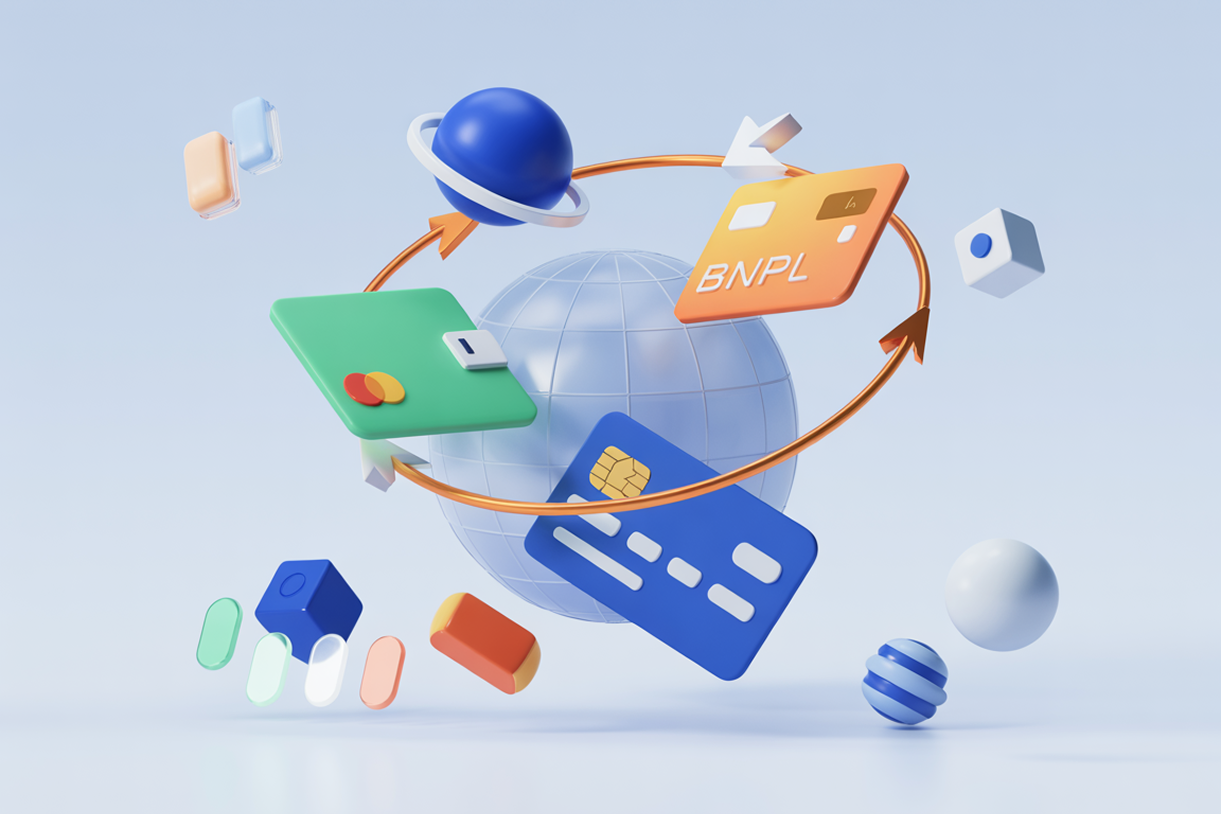Payment gateway vs processor: Key differences you need to know
Discover the crucial differences between payment gateways vs processors. Complete guide to choosing the right payment solutions for your e-commerce business.

Payment gateway vs payment processor - Two halves of an ecommerce whole
Ecommerce needs these two vital components of the online payment process to keep everything going. And while they’re often mentioned together, they play very different roles in getting transactions done.
Here’s what you need to know about how payment gateways and payment processors together form the backbone of payment acceptance.
What is a payment gateway?
A payment gateway is what customers actually see and interact with when making purchases in an online store. It's the secure form where shoppers enter their credit card details – card number, expiration date, and CVV code.
Think of a payment gateway as a digital cashier that collects your payment information and prepares it for processing. Every e-commerce business needs one because it serves as the critical first step in online transactions.
Payment gateways create encrypted connections between your website and payment processors. They act like bulletproof tunnels that protect data from the moment customers hit "submit."
[fs-toc-omit]Key functions of payment gateways
[fs-toc-omit]Security and encryption
Payment gateways encrypt all customer data and use tokenization. This way sensitive card details are converted into harmless digital tokens. This means your actual card number never gets stored on merchant servers. That dramatically reduces data breach risks.
[fs-toc-omit]Fraud prevention
Modern gateways include built-in fraud-fighting tools:
- Address verification system (AVS) checks that compare billing addresses
- CVV verification to confirm security codes match the card
[fs-toc-omit]Easy integration
Gateways offer flexible APIs and ready-made plugins for popular e-commerce platforms. This means faster setup with minimal technical hassles.
[fs-toc-omit]User interface
The gateway creates the payment interface customers see. Whether it's a secure payment page, pop-up window, or embedded checkout form. A smooth, mobile-friendly design here can make or break the customer experience.
[fs-toc-omit]Basic reporting
While not as comprehensive as payment processors, gateways provide real-time dashboards showing:
- Transaction status (approved, declined, pending)
- Success rates
- Basic payment metrics
[fs-toc-omit]The bottom line
Payment gateways don't handle actual money – they're data collectors and protectors. They gather payment information and securely pass it along to the systems that do process transactions.
Understanding the payment gateway vs payment processor distinction is crucial. Gateways are the front-end collectors, while processors handle the behind-the-scenes money movement.
What is a payment processor?
Payment processors are the behind-the-scenes financial communicators that make online transactions actually happen. While customers never see them during online checkout, no money can move without a payment processor coordinating the transaction processing.
Think of payment processors as financial translators sitting between your business and the banking world. They take encrypted payment data from payment gateways and coordinate with banks to move money from your customer's account to your merchant account.
[fs-toc-omit]Key functions of payment processors
[fs-toc-omit]Transaction routing and approval
The processor takes encrypted payment information from the gateway and routes it through card networks (VisaNet for Visa, Mastercard Network for Mastercard) to reach the customer's bank. This enables transaction approval in milliseconds.
[fs-toc-omit]Bank communication and authorization
Payment processors handle all the critical banking conversations:
- Send authorization requests to verify card information
- Check sufficient funds and card validity with fraud detection measures
- Receive approval or decline messages for secure transactions
- Coordinate with your business account to receive funds
[fs-toc-omit]Settlement and fund transfer
Processors manage settlement – the critical step where approved digital payments get batched together (usually daily) and sent for final processing. This is when transaction volume actually moves from customer accounts to your merchant account.
[fs-toc-omit]Chargeback management
When customers dispute credit card payments, processors act as intermediaries between you, the customer's bank, and card brand networks. They provide chargeback management tools and guidance to help resolve disputes.
[fs-toc-omit]Detailed reporting and analytics
Unlike basic gateway reports, processors provide comprehensive payment analytics including:
- Detailed transaction data logs
- Settlement and processing fees reports
- Chargeback data and dispute tracking
- Payment experience performance insights
[fs-toc-omit]The key difference
In the payment gateway vs payment processor comparison: gateways handle online payments collection and secure payment forms, while processors orchestrate the actual payment processing between banks. Processors never interact with customers directly – that's the gateway's job in merchant services.
Payment Gateway vs Payment Processor: Key Differences
[fs-toc-omit]Primary function
Payment Gateway: Customer-facing and data-focused. The gateway handles secure payment collection, encryption, and transmission from your e-commerce business website to the processing network.
Payment Processor: Back-end and finance-focused. The processor manages transaction approval, verification, and orchestrates moving funds between financial institutions.
[fs-toc-omit]Data handling
Payment Gateway: Captures sensitive card information (like card numbers) and immediately protects it through encryption and tokenization for secure transactions.
Payment Processor: Manages secure communication of encrypted transaction data with banks, interpreting authorization requests and orchestrating fund transfers.
[fs-toc-omit] Interaction point
Payment Gateway: The customer's direct touchpoint during online checkout. It's the checkout page or form where credit card payments are entered. Performance here directly impacts your payment experience and brand trust.
Payment Processor: Interacts directly with acquiring banks and card networks. Operates invisibly behind the scenes, but affects transaction approval speed and settlement.
[fs-toc-omit]Security focus
Payment Gateway: Secures data at entry point with encryption, tokenization, and fraud detection tools like AVS/CVV checks to prevent unauthorized access during digital payments.
Payment Processor: Maintains secure payment channels throughout the entire financial flow between issuing banks and acquiring banks while ensuring PCI DSS compliance for the processing infrastructure.
Important note: Many modern payment service providers like Stripe and PayPal bundle both gateway and processing functions. This convenience simplifies merchant services setup but often creates confusion about the difference between a payment gateway and a payment processor that we're clarifying here.
The purchase transaction flow in 10 steps
Here's exactly what happens during online transactions, from customer click to completed payment processing:
[fs-toc-omit]Steps 1-3: Customer and gateway interaction
- Customer initiates payment - Browses your online store, adds items to cart, and proceeds to online checkout
- Gateway collects data - Customer enters card information into the secure payment form, which immediately encrypts and tokenizes the data
- Data sent to processor - Encrypted payment data transfers securely from gateway to payment processor
[fs-toc-omit]Steps 4-7: Payment processor and bank communication
- Processor contacts acquiring bank - Forwards authorization request to your merchant account bank
- Acquiring bank reaches card network - Transmits details to relevant card networks (Visa, Mastercard, etc.)
- Card network contacts issuing bank - Routes request to customer's issuing bank
- Bank responds - Issuing bank verifies funds, checks for fraud, and sends approval/decline through card brand networks
[fs-toc-omit]Steps 8-10: Response and settlement
- Payment processor receives response - Gets authorization from acquiring bank and sends to gateway
- Gateway displays result - Shows "Payment Successful" or "Payment Declined" to customer and merchant
- Funds settled - Actual money moves from customer's business account to your merchant account, typically within 1-3 business days
Neither a payment gateway nor payment processor can work alone. They're two essential halves that together enable secure transactions and credit card processing.
Why this matters for businesses
Understanding payment gateway vs processor differences helps optimize your digital payments infrastructure:
[fs-toc-omit]Choosing the right solutions
Knowing each component's role helps select the best payment service provider - whether bundled solutions or separate specialized services fit your e-commerce business needs.
[fs-toc-omit]Understanding costs
Gateways typically charge per online transactions and monthly fees. Processors involve interchange fees, assessment fees, and processing fees. Understanding both helps control merchant services costs.
[fs-toc-omit]Security and compliance
Each has specific PCI DSS compliance responsibilities. Understanding these roles helps meet regulatory requirements and protect customer payment information.
[fs-toc-omit]Scalability and features
Some gateways excel in payment methods variety or fraud detection. Some processors offer superior international payments or payment analytics. Choose based on your transaction volume needs.
Specific considerations for digital creators
[fs-toc-omit]User experience
Your payment gateway directly impacts online checkout conversion rates. An intuitive, mobile-responsive gateway reduces cart abandonment and improves payment experience.
[fs-toc-omit]Fraud prevention
Understanding both gateway front-line fraud detection and processor real-time verification helps implement comprehensive chargeback management strategies.
[fs-toc-omit]Integration ease
Seamless gateway integration with your online store platform means faster setup and smoother operations for your e-commerce business.
[fs-toc-omit]Global reach
For international payments, processors must handle multiple currencies and cross-border online transactions, while gateways provide localized payment experience.
[fs-toc-omit]Reporting and reconciliation
Gateways provide front-end transaction data while processors offer detailed settlement reports and payment analytics for complete business intelligence.
Gateway vs processor: Different roles, shared mission
While often bundled by payment service providers, payment gateway and processor serve distinct but equally vital functions in online payments.
Understanding the difference between a payment gateway and a payment processor isn't just technical knowledge – it's essential for building secure, efficient digital payments systems that support customer trust in your e-commerce business.
Remember: payment gateway and payment processor isn't an "either-or" choice, but a "both-and" necessity. Optimize both wisely for a strong online payment foundation that scales with your business growth.
Related articles
Ready for more? Check out these related articles that will keep your momentum going. They’re packed with easy-to-follow tips and tricks to help you supercharge your digital goods business.
Take it easy with Easytools
Focus on creating, and let Easytools handle the behind the scenes work.





